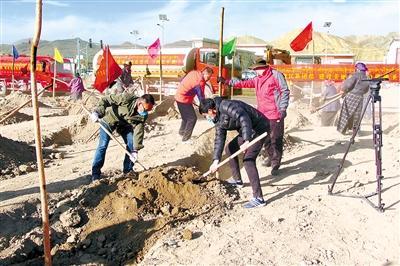By Liu Fang, Zhu Shan Source:China Tibet News 2019-04-19

Photo shows the artificial forests in Nyingchi, southwest China's Tibet Autonomous Region. [China Tibet News/Yuan Haixia]

Photo shows lush trees in Emagang of Namling County, Xigaze City, southwest China's Tibet Autonomous Region. This year, Namling County will add over 33 hectares of economic forest, and begin the rural afforestation on all fronts. [China Tibet News/Yuan Haixia]

Photo shows people planting trees in Dingri County of Xigaze City, southwest China's Tibet Autonomous Region. [China Tibet News/Yuan Haixia]
Tibet, known as "roof of the world", "planet's third pole" and "water tower of Asia", plays a significant role in maintaining the global ecological balance. The eco-environment conservation of Qinghai-Tibet Plateau, an important strategic task, is critical for the long-term development of the Chinese nation.
"Green mountains and clear water, and even snow and ice, are valuable assets that represent our true wealth." Conforming to the idea of respecting nature, following nature's law, and protecting nature, Tibet promotes green development, circular economic development and low-carbon development. Through the eco-cultural construction, people gain a stronger sense of ecological conservation. Besides, the region carries out the building of eco-cultural villages and calls for an environmental-friendly way of life. Currently, 26 villages of Tibet Autonomous Region have been listed among national biological and cultural villages.
Copyright © Xizang Daily & China Xizang News All rights reserved
Reproduction in whole or in part without permissions prohibited
Index Code: 藏 ICP 备 05000021 号
Producer: Xizang Daily International Communication Center